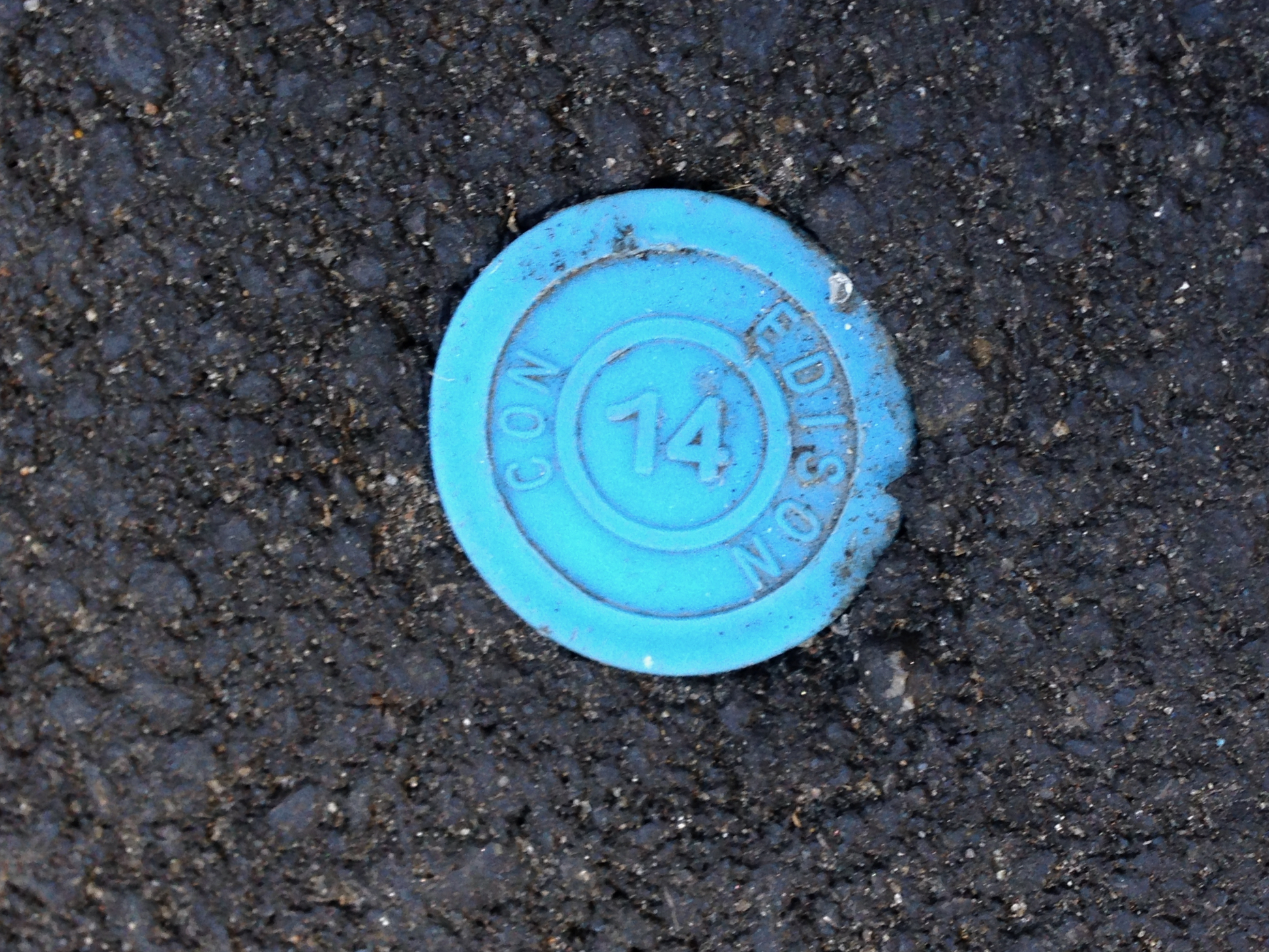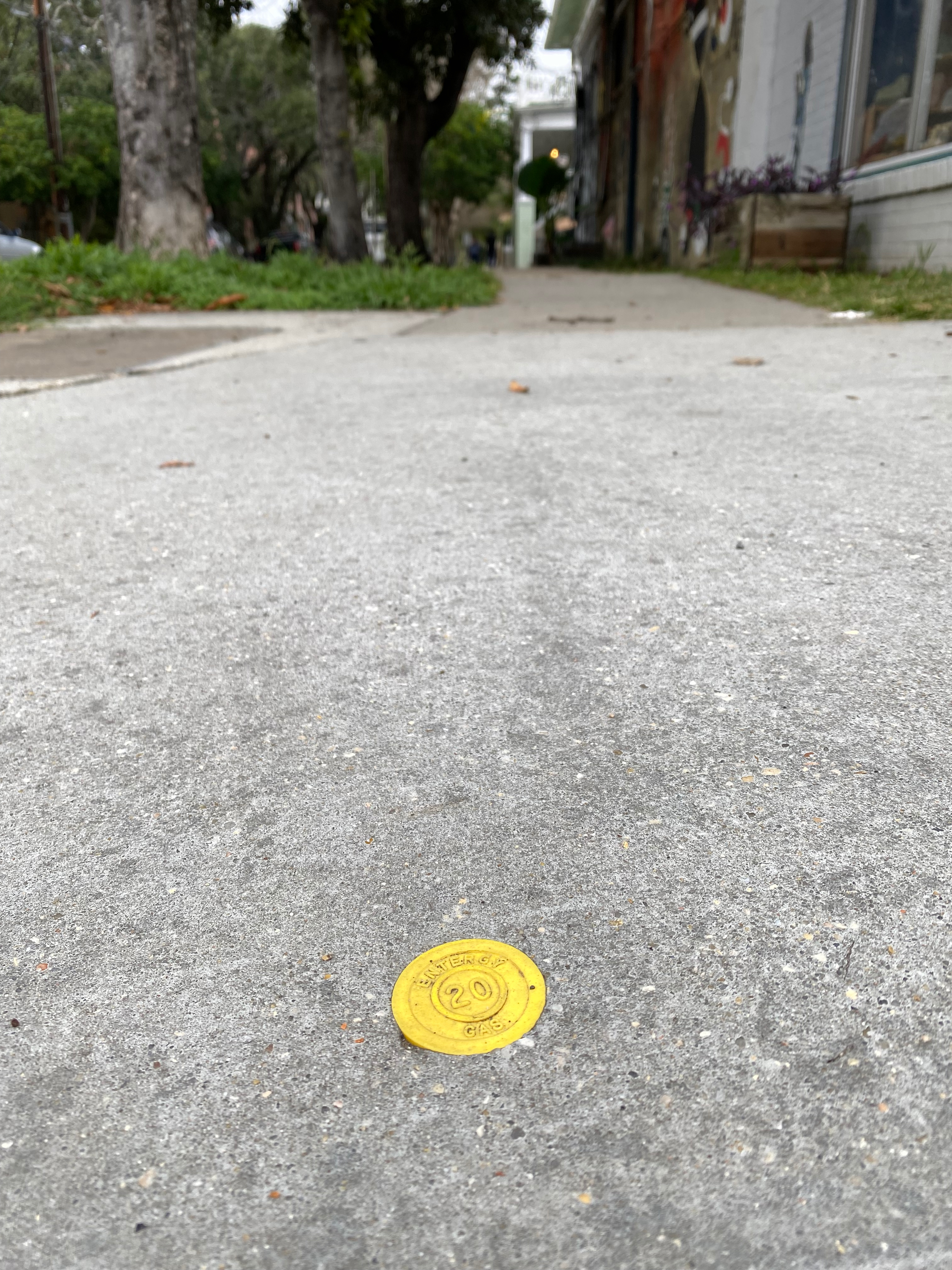Utility Repair Tag on:
[Wikipedia]
[Google]
[Amazon]
 Utility repair tag (also known as A-tag, asphalt tag and road cut medallion) is a plastic color-coded
pavement marker embedded in the top surface of an asphalt
Utility repair tag (also known as A-tag, asphalt tag and road cut medallion) is a plastic color-coded
pavement marker embedded in the top surface of an asphalt
 Some utility companies use utility repair tags as dual-purpose tags. They embed the tags in concrete sidewalk restorations after installing underground utilities. This is to help municipalities to quickly identify the responsible parties of the utility cut repairs. Additional benefit is to have the tags to be visible enough to warn excavators of the utility locations.
Some utility companies use utility repair tags as dual-purpose tags. They embed the tags in concrete sidewalk restorations after installing underground utilities. This is to help municipalities to quickly identify the responsible parties of the utility cut repairs. Additional benefit is to have the tags to be visible enough to warn excavators of the utility locations.
 Utility repair tag (also known as A-tag, asphalt tag and road cut medallion) is a plastic color-coded
pavement marker embedded in the top surface of an asphalt
Utility repair tag (also known as A-tag, asphalt tag and road cut medallion) is a plastic color-coded
pavement marker embedded in the top surface of an asphalt utility cut
A utility cut is a cut and excavation to an existing road surface to install or repair subterranean public utility conduits and equipment. After the utility is installed or repaired, the road needs to be restored which will result in patches on th ...
restoration to identify the responsible party of that pavement repair or patch. The tag is not to be used for identification of an underground utility location
Utility locating is the process of identifying and labeling public utility mains that are underground. These mains may include lines for telecommunication, electricity, electricity distribution, natural gas, cable television, optical fibers, fib ...
.
History
In 1987, a patent application was filed by Richard E. Sanchez to create a flat disc plastic wafer to be used as a utility cut patch identification tag. Prior to that, government regulations required identification washer to be nailed into the pavement, which created many issues. Subsequently, Sanchez made an improvement to add legs to the plastic disc and filed for another patent in 1989. However, the invention was not used for its intended purpose. The tags were used by many municipalities as call before you dig warning markers instead. In 2006, New York City Department of Transportation initiated its A-tag program. The goal was to use the tags to clearly identify the responsible party and the year for each of those pavement patches. Prior to the program, the city used painted color which did not contain enough information to identify the responsible party. Some painted marks could identify the responsible party such as yellow "E" marks forCon Edison
Consolidated Edison, Inc., commonly known as Con Edison (stylized as conEdison) or ConEd, is one of the largest investor-owned energy companies in the United States, with approximately $12 billion in annual revenues as of 2017, and over $62 ...
. The E mark may also include the year such as "E7" for patches made by Con Edison in 2007. However, the painted marks were not consistent.
After Thomas Menino
Thomas Michael Menino (December 27, 1942 – October 30, 2014) was an American politician who served as the mayor of Boston, from 1993 to 2014. He was the city's longest-serving mayor. He was elected mayor in 1993 after first serving three mont ...
, Mayor of Boston, drove on a patch that was settled and he wanted to have it fixed. The city was unable to identify the contractor who were responsible for that patch. That caused the city to search for a solution and eventually adopt the same utility repair tag approach in 2011.
City of Syracuse, New York
Syracuse ( ) is a City (New York), city in and the county seat of Onondaga County, New York, United States. With a population of 148,620 and a Syracuse metropolitan area, metropolitan area of 662,057, it is the fifth-most populated city and 13 ...
adopted its "road cut medallion" program in 2016.
Pittsburgh
Pittsburgh ( ) is a city in Allegheny County, Pennsylvania, United States, and its county seat. It is the List of municipalities in Pennsylvania#Municipalities, second-most populous city in Pennsylvania (after Philadelphia) and the List of Un ...
revised its Right-of-Way Procedures Policy in 2017 to require utility repair tags for all utility cut repairs.
Specifications
Utility repair tags are color coded. The assigned colors may vary depending on municipality regulations. For example, city ofBoston
Boston is the capital and most populous city in the Commonwealth (U.S. state), Commonwealth of Massachusetts in the United States. The city serves as the cultural and Financial centre, financial center of New England, a region of the Northeas ...
and city of Cambridge, Massachusetts
Cambridge ( ) is a city in Middlesex County, Massachusetts, United States. It is a suburb in the Greater Boston metropolitan area, located directly across the Charles River from Boston. The city's population as of the 2020 United States census, ...
use blue for patches made by water utilities, orange for telecommunication companies, yellow for gas utilities, red for electric companies, gray for city contractors, and green for private contractors. On the other hand, Syracuse uses green color for sewer utility cuts. New York City uses a completely different color scheme. The colors are assigned to particular companies or agencies rather than types of utilities. For example, different shades of yellow tags are used for Empire City Subway
Empire City Subway is an American company in New York City which is responsible for maintaining underground conduits in Manhattan and The Bronx, and the manholes by which those conduits are accessed.
History and operations
The company was fo ...
, Long Island Power Authority
Long Island Power Authority (LIPA, "lie-pah") is a municipal subdivision of the State of New York that owns the electric transmission and electric distribution system serving all of Long Island and a portion of Queens in New York City known as ...
, and Buckeye Pipeline. Two shades of blue are for Con Edison
Consolidated Edison, Inc., commonly known as Con Edison (stylized as conEdison) or ConEd, is one of the largest investor-owned energy companies in the United States, with approximately $12 billion in annual revenues as of 2017, and over $62 ...
and cable companies.
Information on the tags includes the company name, agency name or private contractor number, and two digit year in the middle. In case of Boston, the tags also include permittee's bond number.
Sizes of the top of utility repair tags are between and . They should be made of a UV stable Polypropylene
Polypropylene (PP), also known as polypropene, is a thermoplastic polymer used in a wide variety of applications. It is produced via chain-growth polymerization from the monomer Propene, propylene.
Polypropylene belongs to the group of polyolefin ...
material. They should have anchor legs with locking steps to prevent the tags from dislodging from the pavement surface.
Other specifications include how many tags to be installed based on the sizes of the patches, prohibition of using nails, installation procedure on pressing the tags in asphalt before compaction and they should be flushed to the surfaces, and how long the tags should be in place.
Dual-purpose tags
 Some utility companies use utility repair tags as dual-purpose tags. They embed the tags in concrete sidewalk restorations after installing underground utilities. This is to help municipalities to quickly identify the responsible parties of the utility cut repairs. Additional benefit is to have the tags to be visible enough to warn excavators of the utility locations.
Some utility companies use utility repair tags as dual-purpose tags. They embed the tags in concrete sidewalk restorations after installing underground utilities. This is to help municipalities to quickly identify the responsible parties of the utility cut repairs. Additional benefit is to have the tags to be visible enough to warn excavators of the utility locations.
Alternatives
A research in Indiana proposed to useradio-frequency identification
Radio-frequency identification (RFID) uses electromagnetic fields to automatically Automatic identification system, identify and Tracking system, track tags attached to objects. An RFID system consists of a tiny radio transponder called a tag, ...
(RFID) tags to be embedded in the pavements and patches. The information related to a given patch can be read by RFID readers on pavement monitoring vehicles.
See also
*Utility cut
A utility cut is a cut and excavation to an existing road surface to install or repair subterranean public utility conduits and equipment. After the utility is installed or repaired, the road needs to be restored which will result in patches on th ...
*Utility location
Utility locating is the process of identifying and labeling public utility mains that are underground. These mains may include lines for telecommunication, electricity, electricity distribution, natural gas, cable television, optical fibers, fib ...
References
{{Reflist Pavements